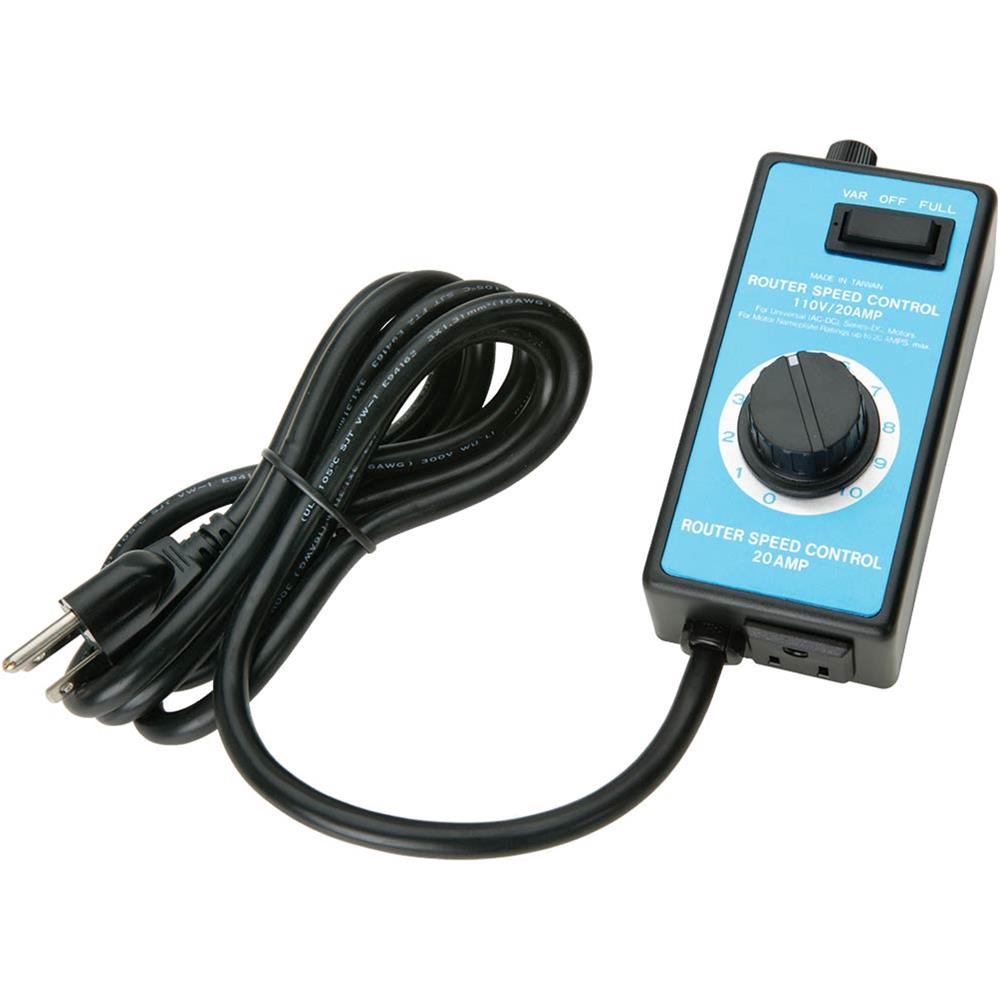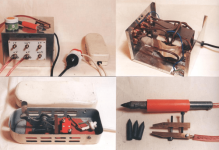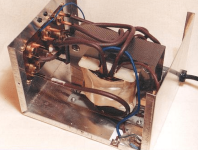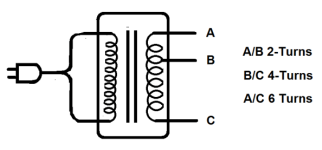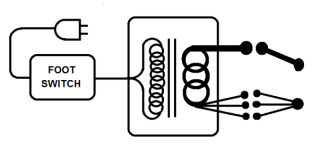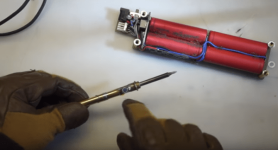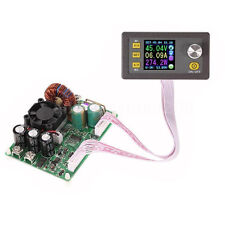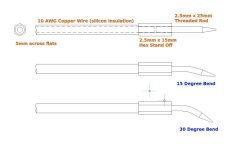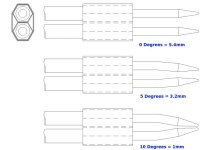This thread is about how to cheaply and easily build a MOT-based RSU for your shop (requires 120VAC input), and also a timer for it, along with a way to adjust the amps.
Here is the best tutorial on MOT function and design theory.
https://www.ibiblio.org/kuphaldt/electricCircuits/AC/AC_9.html
Just about everyone here is already familiar with soldering, You buy a 100W soldering iron and when you plug it in, the tip gets hot. You dab some solder onto the tip to help transfer heat to the connectors/wires/etc...and then, when everything that you need to have bonded has heated up enough, you feed a very thin wire of solder onto the hot joint.
"Resistance Soldering" (RS) means you pass electricity through a piece with two probes (or, you clamp a probe onto a part near the joint, and touch the place you want to get hot with one probe). The voltage is not very relevant, although it is better for it to be low. It is the amps we want, to heat the part. An ES member has achieved good results (attaching thick bus-strips to an 18650 cell-end) with a professional $450 unit from "American Beauty", and although it is adjustable for current, his good results were achieved at 3V and 40A = 120W. If the RSU provides as low as 3V, or as high as 48V, the amps are what will heat up the part (edit: I now believe the volts do have some effect, not fully understood yet for RS).
Low volts puts less strain on your home's 120V AC breakers (voltages above 60V are very dangerous because they can penetrate dry human skin, lower is safer). One of the DIY RSU's I found uses a high-amp 6V battery charger that is adjusted with an inductive-style dimmer switch.
For instance, the average USA home's circuits might be 15A X 120V AC = 1800W. Since we are starting up a sudden high-amp load, we should not go over about 1500W to prevent the breaker from tripping (sudden surge). Then, since we are converting the type of electricity through a cheap and inefficient transformer, we should knock off about 10% for conversion losses, so...now we are down to working with 1500W X 0.90 = 1350W. This means if we convert the household current to 48V, then the most amps our DIY kit will put out is 1350W / 48V = 28A, and we want at least 40A (with the option to go a little higher). By going right to the lowest viable voltage (approx 3V), we can have as much as 1350W / 3V = 450A...way more than we will ever need. 1350W / 12V = 112A, so...12V is the highest voltage I'd recommend for cost of parts and convenience.
Below is a pic of a transformer tucked inside a microwave oven (discharge all capacitors and wear rubber gloves when pulling these out, there can be a nasty high-voltage spark)
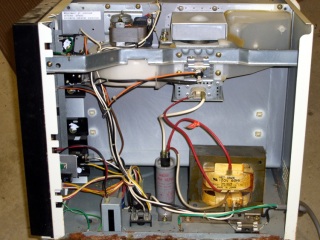
If you have only one type of RS job to do over and over, you can rig-up a Microwave Oven Transformer (MOT) as a simple, crude, and cheap current supply. You can keep swapping-out different wire diameters on the secondary coil until you get the amps that work for the job. That being said, I believe there is a great value in having some small amount of adjustability in the current.

In the pic above, a builder has acquired a transformer from a used microwave oven. He removed the secondary coil (made from many wraps of very fine wire), and then replaced it with 1-1/2 wraps of very thick wire (welding cable). The alternating AC current in the primary coil creates a pulsing magnetic field. That pulsing magnetic field (60-Hz means it reverses its direction 60 times a second), causes the secondary coil of fat wire to generate a low voltage and very high amps (with roughly a 10% loss of total watts due to the inefficiency of this method).
The MOT-based spot-welders require a large MOT, or at the very least, two smaller MOTs in parallel. The smaller microwave ovens are much more common, so an RSU made from a small MOT should be very cheap and easy to put together.
Spot-welders must partially melt the nickel bus-ribbons at above 2700F / 1450C (in one tiny spot), so the pulse must be extremely short in order to prevent heat damage to the cell (less than 200 milliseconds / 200 ms), or 2/10ths of a second. The RSU only needs to heat the solder paste to about 450F (232C) for around 2 seconds. It has been successfully done "by eye" with no timer, but a very simple and cheap timer should be possible for us to identify or build.
Here's a 15-min video of cutting open an 18650 after its been soldered at both ends to see if there is any visual damage (cutting starts at 6:22, comparison at 7:44). The conclusion at 8:40 is that conventional contact soldering might be damaging to the negative, but the positive cathode nipple is far enough away from the active battery material that it was not damaged. The cathode would be even more safe if you were resistance-soldering a tab for 2 seconds (much shorter than the technique shown in the video below, at the 2:00 mark), or...conventionally-soldering a fuse-wire to the cathode.https://www.youtube.com/watch?v=YrqsAGr41uU
Here are websites with info on doing this
http://technitoys.com/diy-resistance-soldering-outfit/
Here's is a very good article on harvesting a MOT out of a free trashed Microwave oven, with pics.
https://softsolder.com/2010/09/08/resistance-soldering-transformer/
https://www.youtube.com/watch?v=-NLy-LL_TGQ&t=374s
There are 100 youtube videos about making a MOT welder, but I consider this video very good. He considers it a failure because he wanted to weld aluminum, but...his resulting amps and volts are exactly what we want.
https://www.youtube.com/watch?v=fQXBNkaB1tU
https://www.youtube.com/watch?v=I3fQjlInC44
great video explaining the physics of MOTs in plain english for newbies
https://www.youtube.com/watch?v=jDuxFEgtSAQ
This guy shows how to connect two MOTs in series to increase amp. he uses two large MOTs to make a welder, but this could be useful for us to use two small MOTs, if big ones become unavailable.
https://youtu.be/hsfgwEUXtTc
If you don't need maximum copper cross-section, but your secondary is getting hot from a frequent duty-cycle, one builder made a secondary out of copper tubing, and flowed coolant through its center. Of course the tubing had heat-shrink over its entire length, and you would need to cut off the "I" section of the core, then re-clamp the E and I back together after inserting the coil.
Just got this, from a 1580W (1.58 kW) large GE built-in microwave.
Aug 2008, Model # HVM1540LN1CS...after the secondary was removed, the "window" space has a cross-section of 15mm X 31mm.
A hobby railroad model enthusiast tutorial
http://www.freerails.com/view_topic.php?id=4345&forum_id=57&page=1
Based on my research, the total power of your MOT RS unit will be the strength of the magnetic field in the transformer "window", times the amount of copper mass passing through that window.
We have all seen higher volts (120V / 240V) passing through much thinner wire without getting that wire hot, so...it is the amps that determine the heat you will get. Once you have wrapped a coil that fills the secondary window, the total output power in watts will be the same regardless of the volts and amps. High turns of thin wire will result in higher volts and lower amps. Fewer turns of thicker wire will be lower volts and higher amps. Since you can adjust the input downwards, and we are only interested in the amps, you should shoot for low volts and high amps. Any volts below 3V may have an inconsistent connection to the work-piece, and any volts above 12V are unhelpful. Any volts above 60V may penetrate dry human skin, so a number or wire wraps equaling 3V-12V is recommended.
Even without adding some type of input adjustment to the power, you can add a tap to the middle of the secondary coil, resulting in three leads exiting the secondary. Since current will only flow through a complete circuit, such a center tap can easily and inexpensively provide three different maximum amp levels, while it also does not limit the original coils' max amps. For instance, imagine we can fit a fat wire into a coil that fill the window by using 6 turns. If we add a center-tap at the 2-turn mark, we immediately allow ourselves to access the sections of the secondary coil at the 2-turn, 4-turn, or the full 6-turns of the coil.
Amps are more complex to accurately measure, but volts are easily tested. Most common MOTs have a primary coil that is wound so that it provides one volt per secondary turn. Our theoretical center-tapped secondary would then provide 2V, 4V, and 6V. If slightly thinner wire is all that is readily available, you can fit more turns into the secondary window. In such a case, consider arranging the center tap to provide 3T, 6T, and 9T, or...4T, 8T, 12T. If you reach 12 turns and there is still significant wasted airspace in the secondary window...consider unwinding it, stripping the insulation from the available wire, and doubling-up its thickness (or even tripling). If you do this, you absolutely must add heat-shrink insulation before re-winding the secondary again.
Once you have tested the resulting MOT/RS unit...and the results are working well, it is advisable to spray or brush some varnish over the secondary coil in order to reduce vibration from the alternating magnetic field, Such vibration will cause chafing and will wear away the insulation, eventually causing a short.
Here is the best tutorial on MOT function and design theory.
https://www.ibiblio.org/kuphaldt/electricCircuits/AC/AC_9.html
Just about everyone here is already familiar with soldering, You buy a 100W soldering iron and when you plug it in, the tip gets hot. You dab some solder onto the tip to help transfer heat to the connectors/wires/etc...and then, when everything that you need to have bonded has heated up enough, you feed a very thin wire of solder onto the hot joint.
"Resistance Soldering" (RS) means you pass electricity through a piece with two probes (or, you clamp a probe onto a part near the joint, and touch the place you want to get hot with one probe). The voltage is not very relevant, although it is better for it to be low. It is the amps we want, to heat the part. An ES member has achieved good results (attaching thick bus-strips to an 18650 cell-end) with a professional $450 unit from "American Beauty", and although it is adjustable for current, his good results were achieved at 3V and 40A = 120W. If the RSU provides as low as 3V, or as high as 48V, the amps are what will heat up the part (edit: I now believe the volts do have some effect, not fully understood yet for RS).
Low volts puts less strain on your home's 120V AC breakers (voltages above 60V are very dangerous because they can penetrate dry human skin, lower is safer). One of the DIY RSU's I found uses a high-amp 6V battery charger that is adjusted with an inductive-style dimmer switch.
For instance, the average USA home's circuits might be 15A X 120V AC = 1800W. Since we are starting up a sudden high-amp load, we should not go over about 1500W to prevent the breaker from tripping (sudden surge). Then, since we are converting the type of electricity through a cheap and inefficient transformer, we should knock off about 10% for conversion losses, so...now we are down to working with 1500W X 0.90 = 1350W. This means if we convert the household current to 48V, then the most amps our DIY kit will put out is 1350W / 48V = 28A, and we want at least 40A (with the option to go a little higher). By going right to the lowest viable voltage (approx 3V), we can have as much as 1350W / 3V = 450A...way more than we will ever need. 1350W / 12V = 112A, so...12V is the highest voltage I'd recommend for cost of parts and convenience.
Below is a pic of a transformer tucked inside a microwave oven (discharge all capacitors and wear rubber gloves when pulling these out, there can be a nasty high-voltage spark)

If you have only one type of RS job to do over and over, you can rig-up a Microwave Oven Transformer (MOT) as a simple, crude, and cheap current supply. You can keep swapping-out different wire diameters on the secondary coil until you get the amps that work for the job. That being said, I believe there is a great value in having some small amount of adjustability in the current.
In the pic above, a builder has acquired a transformer from a used microwave oven. He removed the secondary coil (made from many wraps of very fine wire), and then replaced it with 1-1/2 wraps of very thick wire (welding cable). The alternating AC current in the primary coil creates a pulsing magnetic field. That pulsing magnetic field (60-Hz means it reverses its direction 60 times a second), causes the secondary coil of fat wire to generate a low voltage and very high amps (with roughly a 10% loss of total watts due to the inefficiency of this method).
The MOT-based spot-welders require a large MOT, or at the very least, two smaller MOTs in parallel. The smaller microwave ovens are much more common, so an RSU made from a small MOT should be very cheap and easy to put together.
Spot-welders must partially melt the nickel bus-ribbons at above 2700F / 1450C (in one tiny spot), so the pulse must be extremely short in order to prevent heat damage to the cell (less than 200 milliseconds / 200 ms), or 2/10ths of a second. The RSU only needs to heat the solder paste to about 450F (232C) for around 2 seconds. It has been successfully done "by eye" with no timer, but a very simple and cheap timer should be possible for us to identify or build.
Here's a 15-min video of cutting open an 18650 after its been soldered at both ends to see if there is any visual damage (cutting starts at 6:22, comparison at 7:44). The conclusion at 8:40 is that conventional contact soldering might be damaging to the negative, but the positive cathode nipple is far enough away from the active battery material that it was not damaged. The cathode would be even more safe if you were resistance-soldering a tab for 2 seconds (much shorter than the technique shown in the video below, at the 2:00 mark), or...conventionally-soldering a fuse-wire to the cathode.https://www.youtube.com/watch?v=YrqsAGr41uU
Here are websites with info on doing this
http://technitoys.com/diy-resistance-soldering-outfit/
Here's is a very good article on harvesting a MOT out of a free trashed Microwave oven, with pics.
https://softsolder.com/2010/09/08/resistance-soldering-transformer/
https://www.youtube.com/watch?v=-NLy-LL_TGQ&t=374s
There are 100 youtube videos about making a MOT welder, but I consider this video very good. He considers it a failure because he wanted to weld aluminum, but...his resulting amps and volts are exactly what we want.
https://www.youtube.com/watch?v=fQXBNkaB1tU
https://www.youtube.com/watch?v=I3fQjlInC44
great video explaining the physics of MOTs in plain english for newbies
https://www.youtube.com/watch?v=jDuxFEgtSAQ
This guy shows how to connect two MOTs in series to increase amp. he uses two large MOTs to make a welder, but this could be useful for us to use two small MOTs, if big ones become unavailable.
https://youtu.be/hsfgwEUXtTc
If you don't need maximum copper cross-section, but your secondary is getting hot from a frequent duty-cycle, one builder made a secondary out of copper tubing, and flowed coolant through its center. Of course the tubing had heat-shrink over its entire length, and you would need to cut off the "I" section of the core, then re-clamp the E and I back together after inserting the coil.
Just got this, from a 1580W (1.58 kW) large GE built-in microwave.
Aug 2008, Model # HVM1540LN1CS...after the secondary was removed, the "window" space has a cross-section of 15mm X 31mm.
A hobby railroad model enthusiast tutorial
http://www.freerails.com/view_topic.php?id=4345&forum_id=57&page=1
Based on my research, the total power of your MOT RS unit will be the strength of the magnetic field in the transformer "window", times the amount of copper mass passing through that window.
We have all seen higher volts (120V / 240V) passing through much thinner wire without getting that wire hot, so...it is the amps that determine the heat you will get. Once you have wrapped a coil that fills the secondary window, the total output power in watts will be the same regardless of the volts and amps. High turns of thin wire will result in higher volts and lower amps. Fewer turns of thicker wire will be lower volts and higher amps. Since you can adjust the input downwards, and we are only interested in the amps, you should shoot for low volts and high amps. Any volts below 3V may have an inconsistent connection to the work-piece, and any volts above 12V are unhelpful. Any volts above 60V may penetrate dry human skin, so a number or wire wraps equaling 3V-12V is recommended.
Even without adding some type of input adjustment to the power, you can add a tap to the middle of the secondary coil, resulting in three leads exiting the secondary. Since current will only flow through a complete circuit, such a center tap can easily and inexpensively provide three different maximum amp levels, while it also does not limit the original coils' max amps. For instance, imagine we can fit a fat wire into a coil that fill the window by using 6 turns. If we add a center-tap at the 2-turn mark, we immediately allow ourselves to access the sections of the secondary coil at the 2-turn, 4-turn, or the full 6-turns of the coil.
Amps are more complex to accurately measure, but volts are easily tested. Most common MOTs have a primary coil that is wound so that it provides one volt per secondary turn. Our theoretical center-tapped secondary would then provide 2V, 4V, and 6V. If slightly thinner wire is all that is readily available, you can fit more turns into the secondary window. In such a case, consider arranging the center tap to provide 3T, 6T, and 9T, or...4T, 8T, 12T. If you reach 12 turns and there is still significant wasted airspace in the secondary window...consider unwinding it, stripping the insulation from the available wire, and doubling-up its thickness (or even tripling). If you do this, you absolutely must add heat-shrink insulation before re-winding the secondary again.
Once you have tested the resulting MOT/RS unit...and the results are working well, it is advisable to spray or brush some varnish over the secondary coil in order to reduce vibration from the alternating magnetic field, Such vibration will cause chafing and will wear away the insulation, eventually causing a short.


